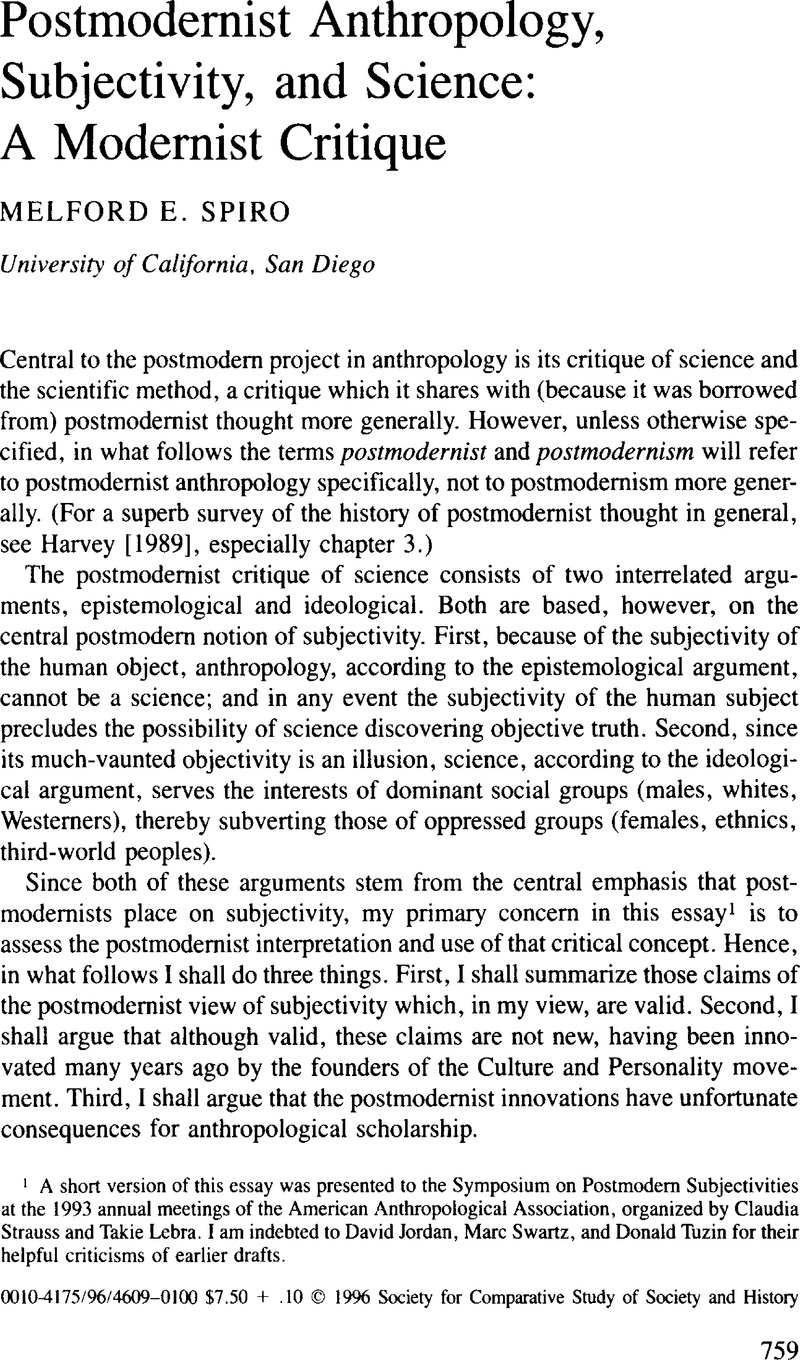Crossref Citations
This article has been cited by the following publications. This list is generated based on data provided by Crossref.
Bowlin, John R.
and
Stromberg, Peter G.
1997.
Representation and Reality in the Study of Culture.
American Anthropologist,
Vol. 99,
Issue. 1,
p.
123.
Durrenberger, E.
and
Erem, Suzan
1999.
The Abstract, the Concrete, the Political, and the Academic: Anthropology and a Labor Union in the United States.
Human Organization,
Vol. 58,
Issue. 3,
p.
305.
Campbell, John
2002.
A critical appraisal of participatory methods in development research.
International Journal of Social Research Methodology,
Vol. 5,
Issue. 1,
p.
19.
Boggs, James P.
2004.
The Culture Concept as Theory, in Context.
Current Anthropology,
Vol. 45,
Issue. 2,
p.
187.
Grieshaber, Susan
and
Ryan, Sharon
2005.
Practical Transformations and Transformational Practices: Globalization, Postmodernism, and Early Childhood Education.
Vol. 14,
Issue. ,
p.
3.
Narotzky, Susana
2007.
The Project in the Model.
Current Anthropology,
Vol. 48,
Issue. 3,
p.
403.
Crasnow, Sharon
2007.
Philosophy of Anthropology and Sociology.
p.
755.
HO, WING‐CHUNG
2008.
Writing Experience: Does Ethnography Convey a Crisis of Representation, or an Ontological Break with the Everyday World?.
Canadian Review of Sociology/Revue canadienne de sociologie,
Vol. 45,
Issue. 4,
p.
343.
Perry, George
and
Mace, Ruth
2010.
The lack of acceptance of evolutionary approaches to human behaviour.
Journal of Evolutionary Psychology,
Vol. 8,
Issue. 2,
p.
105.
Merrell, Floyd
2011.
Conformity and resistance as cultural process in postmodern globalizing times.
Semiotica,
Vol. 2011,
Issue. 183,
Patterson, Orlando
2014.
Making Sense of Culture.
Annual Review of Sociology,
Vol. 40,
Issue. 1,
p.
1.
Mustafa Ali, Dr
and
R. Taylor, Arthur
2014.
Postmodernist and consumerist influences on information consumption.
Kybernetes,
Vol. 43,
Issue. 6,
p.
924.
Reidy, Eugenie
2017.
Speaking Back, Striking Back.
Anthropology in Action,
Vol. 24,
Issue. 3,
p.
11.
Alonso Población, Enrique
Pena Castro, María Jesús
and
Fidalgo Castro, Alberto
2018.
Cambio social y cultura: clase, poder y tradición en Timor Oriental.
Revista Latina de Sociología,
Vol. 8,
Issue. 2,
p.
1.
Cook, Garrett
2018.
The International Encyclopedia of Anthropology.
p.
1.
Kavanagh, Christopher M.
2018.
Too Much, Too Little, or the Wrong Kind of ‘Theory’ in the Study of Religions?.
Method & Theory in the Study of Religion,
Vol. 30,
Issue. 4-5,
p.
463.
Lamichhane, R.
and
Maltese, A.
2019.
Technology Integration in Chemistry Education and Research (TICER).
Vol. 1318,
Issue. ,
p.
83.
Drcmánková, Karolína
2019.
Antropologie a naturalismus.
Anthropologia integra,
Vol. 10,
Issue. 1,
p.
45.
Murali, Komal Patel
2020.
End of Life Decision-Making: Watson’s Theory of Human Caring.
Nursing Science Quarterly,
Vol. 33,
Issue. 1,
p.
73.
LILJEBLAD, Jonathan
2020.
Recognizing the Value of Constitutional Origins - Kevin Y. L. Tan and Ngoc Son Bui, eds., Constitutional Foundings in Southeast Asia (New York: Hart Publishing, 2019) pp 352. Hardcover: $85.00..
Asian Journal of Law and Society,
Vol. 7,
Issue. 1,
p.
191.





